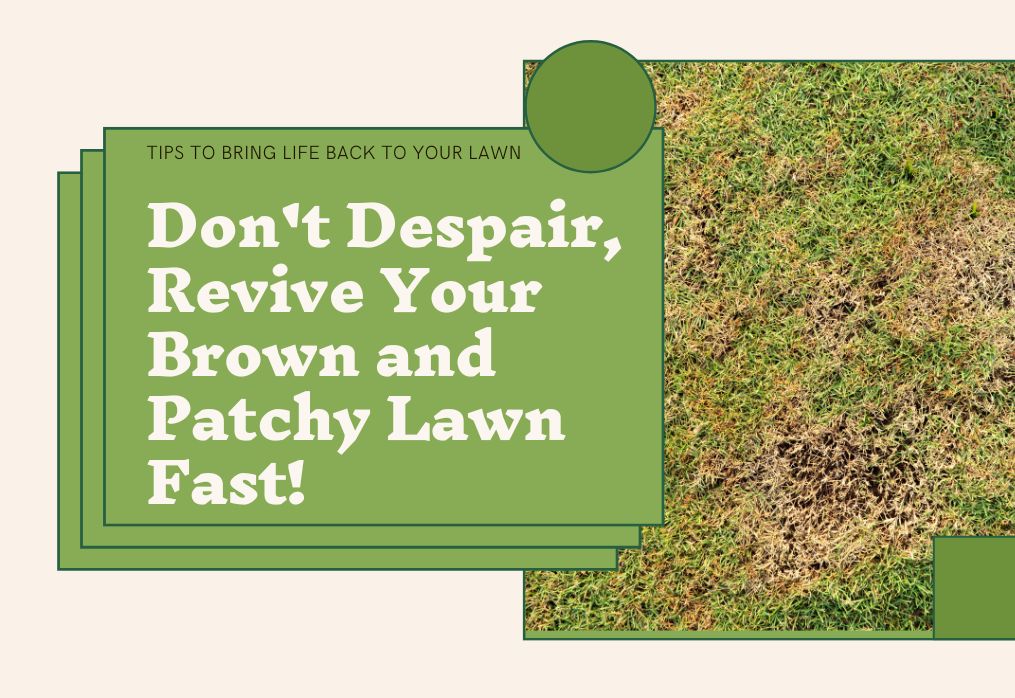Brown and Patchy Lawn? Don’t Despair, Revive It Fast!
Brown and Patchy Lawn Don’t Despair Revive It Fast
Does your once lush grass resemble a mixed quilt of brown and green? Fear not, fellow lawn lovers! With a little TLC, you can return your green oasis to its former beauty. Here’s how to identify the problem and get your lawn back on track:
1. Diagnose the culprit:
Uneven Watering: Is one place usually dry while another is soggy? Adjust your watering plan for an even spread. Thatch Buildup: Does water pool on the surface? Thatch, a layer of dead grass, stops water and nutrients from reaching the roots. Dethatching might be necessary.
Compacted dirt: Does the dirt feel hard and impenetrable? Aeration alleviates pressure, allowing air, water, and nutrients to reach the roots.
Nutrient Deficiency: Is the earth missing important elements? A soil test can reveal deficiencies and lead to proper fertilization.
Fungal Disease: Are there circular spots with defined edges? Fungal diseases grow in moist settings. Fungicide application or cultural habits like better drainage can help.
Grubs or insects: Are there dead spots with obvious damage? Grubs and insects feast on roots. Consider using suitable pesticides or nematodes.
2. Take action against Brown and Patchy Lawn Don’t Despair Revive It Fast
Water wisely: deep, infrequent watering encourages strong root growth. Water early in the morning to avoid evaporation.
Dethatching: If the thatch covering exceeds ½ inch, dethatching removes the barrier and supports healthy growth.
Aerate: Aeration provides pathways for air, water, and nutrients to reach the roots. Consider core ventilation for packed soil.
Fertilize: Use an appropriate fertilizer based on your soil test findings. Avoid over-fertilizing, which can worsen problems.
Manage Pests: If grubs or insects are the cause, apply approved insecticides or nematodes according to label directions.
Combat Fungus: For fungal diseases, find the specific type and add suitable fungicides or cultural practices like better drainage. You can read about Natural Ways to Eliminate Weeds in Your Garden
3. Bonus Tips:
Mow High: Taller grass covers the soil, holds moisture, and discourages weeds.
Sharpen Your Blades: Dull blades tear grass, leaving it open to disease.
Edge Regularly: Defined edges make a neat appearance and discourage weeds.
Seek expert help: If DIY methods fail, ask a lawn care expert for personalized help.
Remember: Reviving a lawn takes time and steady work. By following these steps and treating the root cause, you’ll be well on your way to a lush, green lawn you can be proud of!
Last Updated on 1 year ago by Anjali Mehra Ph.D. in Horticulture (Punjab Agricultural University)
- Why Lawn Grass Fails After Installation (Real Indian Case Studies) - December 25, 2025
- Nilgiri Grass vs Korean Grass – Price, Look & Maintenance Compared - December 23, 2025
- Delhi Pollution & Dust-Proof Lawn Care Guide - December 20, 2025
